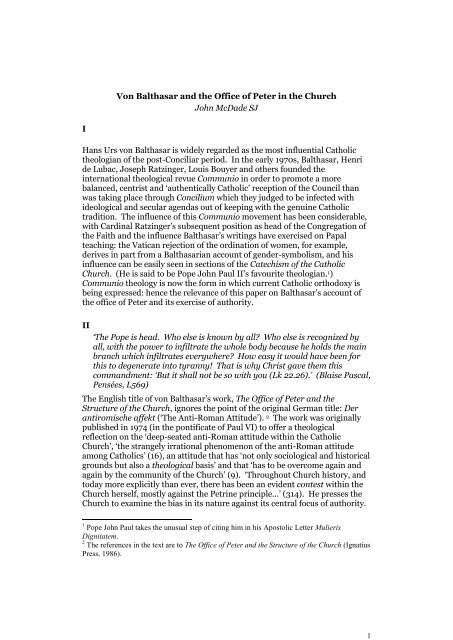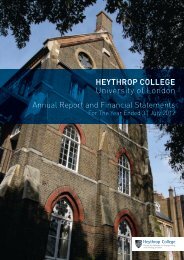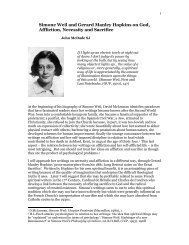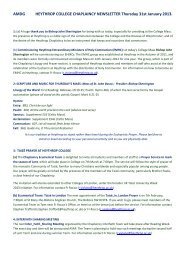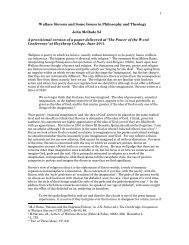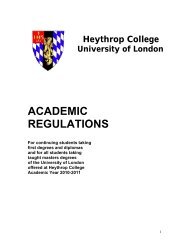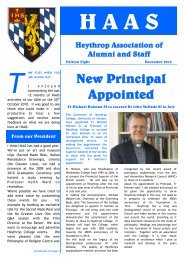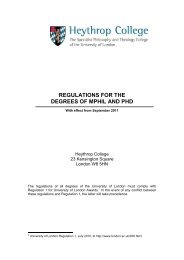Von Balthasar and the Office of Peter in the Church
Von Balthasar and the Office of Peter in the Church
Von Balthasar and the Office of Peter in the Church
Create successful ePaper yourself
Turn your PDF publications into a flip-book with our unique Google optimized e-Paper software.
1<br />
<strong>Von</strong> <strong>Balthasar</strong> <strong>and</strong> <strong>the</strong> <strong>Office</strong> <strong>of</strong> <strong>Peter</strong> <strong>in</strong> <strong>the</strong> <strong>Church</strong><br />
John McDade SJ<br />
I<br />
Hans Urs von <strong>Balthasar</strong> is widely regarded as <strong>the</strong> most <strong>in</strong>fluential Catholic<br />
<strong>the</strong>ologian <strong>of</strong> <strong>the</strong> post-Conciliar period. In <strong>the</strong> early 1970s, <strong>Balthasar</strong>, Henri<br />
de Lubac, Joseph Ratz<strong>in</strong>ger, Louis Bouyer <strong>and</strong> o<strong>the</strong>rs founded <strong>the</strong><br />
<strong>in</strong>ternational <strong>the</strong>ological revue Communio <strong>in</strong> order to promote a more<br />
balanced, centrist <strong>and</strong> „au<strong>the</strong>ntically Catholic‟ reception <strong>of</strong> <strong>the</strong> Council than<br />
was tak<strong>in</strong>g place through Concilium which <strong>the</strong>y judged to be <strong>in</strong>fected with<br />
ideological <strong>and</strong> secular agendas out <strong>of</strong> keep<strong>in</strong>g with <strong>the</strong> genu<strong>in</strong>e Catholic<br />
tradition. The <strong>in</strong>fluence <strong>of</strong> this Communio movement has been considerable,<br />
with Card<strong>in</strong>al Ratz<strong>in</strong>ger‟s subsequent position as head <strong>of</strong> <strong>the</strong> Congregation <strong>of</strong><br />
<strong>the</strong> Faith <strong>and</strong> <strong>the</strong> <strong>in</strong>fluence <strong>Balthasar</strong>‟s writ<strong>in</strong>gs have exercised on Papal<br />
teach<strong>in</strong>g: <strong>the</strong> Vatican rejection <strong>of</strong> <strong>the</strong> ord<strong>in</strong>ation <strong>of</strong> women, for example,<br />
derives <strong>in</strong> part from a <strong>Balthasar</strong>ian account <strong>of</strong> gender-symbolism, <strong>and</strong> his<br />
<strong>in</strong>fluence can be easily seen <strong>in</strong> sections <strong>of</strong> <strong>the</strong> Catechism <strong>of</strong> <strong>the</strong> Catholic<br />
<strong>Church</strong>. (He is said to be Pope John Paul II‟s favourite <strong>the</strong>ologian. 1 )<br />
Communio <strong>the</strong>ology is now <strong>the</strong> form <strong>in</strong> which current Catholic orthodoxy is<br />
be<strong>in</strong>g expressed: hence <strong>the</strong> relevance <strong>of</strong> this paper on <strong>Balthasar</strong>‟s account <strong>of</strong><br />
<strong>the</strong> <strong>of</strong>fice <strong>of</strong> <strong>Peter</strong> <strong>and</strong> its exercise <strong>of</strong> authority.<br />
II<br />
‘The Pope is head. Who else is known by all Who else is recognized by<br />
all, with <strong>the</strong> power to <strong>in</strong>filtrate <strong>the</strong> whole body because he holds <strong>the</strong> ma<strong>in</strong><br />
branch which <strong>in</strong>filtrates everywhere How easy it would have been for<br />
this to degenerate <strong>in</strong>to tyranny! That is why Christ gave <strong>the</strong>m this<br />
comm<strong>and</strong>ment: ‘But it shall not be so with you (Lk 22.26).’ (Blaise Pascal,<br />
Pensées, L569)<br />
The English title <strong>of</strong> von <strong>Balthasar</strong>‟s work, The <strong>Office</strong> <strong>of</strong> <strong>Peter</strong> <strong>and</strong> <strong>the</strong><br />
Structure <strong>of</strong> <strong>the</strong> <strong>Church</strong>, ignores <strong>the</strong> po<strong>in</strong>t <strong>of</strong> <strong>the</strong> orig<strong>in</strong>al German title: Der<br />
antiromische affekt („The Anti-Roman Attitude‟). 2 The work was orig<strong>in</strong>ally<br />
published <strong>in</strong> 1974 (<strong>in</strong> <strong>the</strong> pontificate <strong>of</strong> Paul VI) to <strong>of</strong>fer a <strong>the</strong>ological<br />
reflection on <strong>the</strong> „deep-seated anti-Roman attitude with<strong>in</strong> <strong>the</strong> Catholic<br />
<strong>Church</strong>‟, „<strong>the</strong> strangely irrational phenomenon <strong>of</strong> <strong>the</strong> anti-Roman attitude<br />
among Catholics‟ (16), an attitude that has „not only sociological <strong>and</strong> historical<br />
grounds but also a <strong>the</strong>ological basis‟ <strong>and</strong> that „has to be overcome aga<strong>in</strong> <strong>and</strong><br />
aga<strong>in</strong> by <strong>the</strong> community <strong>of</strong> <strong>the</strong> <strong>Church</strong>‟ (9). „Throughout <strong>Church</strong> history, <strong>and</strong><br />
today more explicitly than ever, <strong>the</strong>re has been an evident contest with<strong>in</strong> <strong>the</strong><br />
<strong>Church</strong> herself, mostly aga<strong>in</strong>st <strong>the</strong> Petr<strong>in</strong>e pr<strong>in</strong>ciple...‟ (314). He presses <strong>the</strong><br />
<strong>Church</strong> to exam<strong>in</strong>e <strong>the</strong> bias <strong>in</strong> its nature aga<strong>in</strong>st its central focus <strong>of</strong> authority.<br />
1 Pope John Paul takes <strong>the</strong> unusual step <strong>of</strong> cit<strong>in</strong>g him <strong>in</strong> his Apostolic Letter Mulieris<br />
Dignitatem.<br />
2 The references <strong>in</strong> <strong>the</strong> text are to The <strong>Office</strong> <strong>of</strong> <strong>Peter</strong> <strong>and</strong> <strong>the</strong> Structure <strong>of</strong> <strong>the</strong> <strong>Church</strong> (Ignatius<br />
Press, 1986).
2<br />
In <strong>Balthasar</strong>‟s view, <strong>the</strong> Papacy is misrepresented if it is pictured at <strong>the</strong> top <strong>of</strong><br />
an ecclesial pyramid: he regards this as a legacy <strong>of</strong> Imperial Rome <strong>and</strong> a<br />
reaction to <strong>the</strong> encroachments <strong>of</strong> medieval emperors. Such an image distorts<br />
<strong>the</strong> relation <strong>of</strong> <strong>the</strong> Papacy to <strong>the</strong> rest <strong>of</strong> <strong>the</strong> <strong>Church</strong> because <strong>the</strong> Pope is not<br />
„above‟ <strong>the</strong> <strong>Church</strong> <strong>in</strong> any serious sense, nor is <strong>the</strong> <strong>Church</strong> „under‟ him („..but it<br />
shall not be so with you.‟ (Lk 22.26). Only Jesus st<strong>and</strong>s above <strong>the</strong> <strong>Church</strong> as<br />
its Lord (308). Equally, <strong>Balthasar</strong> has little time for attempts to remove <strong>the</strong><br />
sc<strong>and</strong>alon <strong>of</strong> <strong>the</strong> Petr<strong>in</strong>e <strong>Office</strong> by s<strong>of</strong>ten<strong>in</strong>g it <strong>in</strong>to an Orthodox „honorary<br />
primacy‟ based upon <strong>the</strong> autonomy <strong>of</strong> particular churches (77). Instead, <strong>the</strong><br />
Papacy is one <strong>of</strong> <strong>the</strong> elements with<strong>in</strong> <strong>the</strong> complex identity <strong>of</strong> <strong>the</strong> <strong>Church</strong>: it is<br />
both a primary feature <strong>of</strong> <strong>the</strong> <strong>Church</strong> as „<strong>the</strong> guarantor <strong>of</strong> concrete unity <strong>in</strong><br />
<strong>the</strong> concrete centre <strong>of</strong> <strong>the</strong> <strong>Church</strong>‟ (127), <strong>and</strong> relative, „one <strong>of</strong> several<br />
<strong>in</strong>dispensable elements <strong>in</strong> <strong>the</strong> ecclesiastical structure‟ which, by <strong>the</strong>ir very<br />
relationship to one ano<strong>the</strong>r constitute <strong>the</strong> <strong>Church</strong>‟s identity (21). Hence both<br />
Protestantism <strong>and</strong> Papolatry are unacceptable, because <strong>the</strong>y dissolve <strong>the</strong><br />
differentiated character <strong>of</strong> <strong>the</strong> <strong>Church</strong>, one by excis<strong>in</strong>g episcopal <strong>and</strong> papal<br />
authority from <strong>the</strong> structure, <strong>the</strong> o<strong>the</strong>r by exalt<strong>in</strong>g <strong>the</strong> Pope above everyth<strong>in</strong>g<br />
else. He quotes Möhler‟s sharp comment on <strong>the</strong>ir common source <strong>in</strong> an<br />
exaggerated egoism:<br />
Protestantism is papism carried to <strong>the</strong> extreme, that is, complete<br />
egoism <strong>in</strong> pr<strong>in</strong>ciple. In papism each gives himself unconditionally to<br />
one person: <strong>in</strong> Protestantism, each one is <strong>in</strong> a position to oppose all<br />
o<strong>the</strong>rs (<strong>in</strong>s<strong>of</strong>ar as he makes <strong>of</strong> himself <strong>the</strong> pr<strong>in</strong>ciple <strong>of</strong> <strong>in</strong>terpretation <strong>of</strong><br />
revelation) (172).<br />
He prefers to speak <strong>of</strong> <strong>the</strong> „multi-dimensional reality‟ <strong>of</strong> <strong>the</strong> church‟ (26) <strong>the</strong><br />
„force-fields that bear upon <strong>the</strong> church‟ (22), <strong>the</strong> „network <strong>of</strong> tensions <strong>in</strong> <strong>the</strong><br />
<strong>Church</strong>‟(24). In <strong>the</strong> <strong>Church</strong>, <strong>the</strong>re are „more fundamental tensions‟ than that<br />
between primacy <strong>and</strong> collegiality or „monarchy‟ <strong>and</strong> „democracy‟ (sociological<br />
parallels from secular society are dismissed by him as <strong>in</strong>adequate to <strong>the</strong><br />
mysterium). In his view, <strong>the</strong> necessary tensions <strong>in</strong> <strong>the</strong> <strong>Church</strong> are nei<strong>the</strong>r <strong>the</strong><br />
symptoms <strong>of</strong> spiritual shortcom<strong>in</strong>gs nor flaws which can be remedied by<br />
structural change: <strong>the</strong>y are constitutive <strong>of</strong> <strong>the</strong> <strong>Church</strong> because <strong>the</strong> <strong>Church</strong> is<br />
<strong>in</strong>herently a complex, multi-dimensional network <strong>of</strong> pr<strong>in</strong>ciples which, <strong>in</strong><br />
<strong>the</strong>ir <strong>in</strong>teraction constitute <strong>the</strong> reality <strong>of</strong> <strong>the</strong> <strong>Church</strong> founded by Christ. (He<br />
rejects <strong>the</strong> idea that <strong>the</strong> orig<strong>in</strong>al form <strong>of</strong> <strong>the</strong> <strong>Church</strong> was a charismatic<br />
bro<strong>the</strong>rhood <strong>of</strong> equality, only later corrupted by patriarchal patterns <strong>of</strong><br />
government. Instead, <strong>the</strong> <strong>Church</strong> as shaped by Christ <strong>in</strong> its period <strong>of</strong> orig<strong>in</strong>s<br />
is differentiated <strong>and</strong> <strong>in</strong>vested with centres <strong>of</strong> authority, adjudication <strong>and</strong><br />
service.)<br />
He presents an account <strong>of</strong> <strong>the</strong> <strong>Church</strong> <strong>in</strong> which Mary, <strong>Peter</strong> <strong>and</strong> <strong>the</strong> o<strong>the</strong>r<br />
figures around Jesus form a network <strong>of</strong> pr<strong>in</strong>ciples which, <strong>in</strong> <strong>the</strong>ir mutuality,<br />
<strong>in</strong>teraction <strong>and</strong> tension, form <strong>the</strong> <strong>Church</strong> which relates to its Lord. <strong>Balthasar</strong><br />
approves <strong>of</strong> Congar‟s def<strong>in</strong>ition <strong>of</strong> Catholicity as „<strong>the</strong> dynamic universality <strong>of</strong><br />
<strong>the</strong> pr<strong>in</strong>ciples which yield her unity‟ (323); <strong>and</strong> proposes an ecclesiology <strong>of</strong><br />
symbolic archetypes as a way <strong>of</strong> identify<strong>in</strong>g <strong>the</strong>se constitutive pr<strong>in</strong>ciples <strong>and</strong><br />
missions which form <strong>the</strong> Catholica.
3<br />
III<br />
His approach is simple: <strong>the</strong> „larger unity‟ <strong>of</strong> <strong>the</strong> <strong>Church</strong> corresponds to <strong>the</strong><br />
„constellation‟ <strong>of</strong> persons around Jesus <strong>in</strong> <strong>the</strong> New Testament, a constellation<br />
<strong>of</strong> „real symbols‟ which designate particular missions with<strong>in</strong> <strong>the</strong> <strong>Church</strong>,<br />
form<strong>in</strong>g <strong>the</strong> dimensions <strong>of</strong> <strong>the</strong> Catholica (309). The historical Jesus st<strong>and</strong>s<br />
with<strong>in</strong> a „constitutive human group‟; withdraw<strong>in</strong>g him from this differentiated<br />
network makes him (<strong>and</strong> Christology) „hopelessly abstract‟ (136). The <strong>Church</strong><br />
is born <strong>in</strong> <strong>the</strong> relationships Christ establishes <strong>in</strong> „<strong>the</strong> period <strong>of</strong> orig<strong>in</strong>s‟ (158)<br />
<strong>and</strong> <strong>the</strong>ir symbolic pattern forms <strong>the</strong> subsequent pattern <strong>of</strong> <strong>the</strong> <strong>Church</strong> <strong>in</strong><br />
which <strong>the</strong> Risen Jesus cont<strong>in</strong>ues to give missions: it is this subsistent pattern<br />
<strong>of</strong> cont<strong>in</strong>uity between „<strong>the</strong>n‟ <strong>and</strong> „now‟ which makes <strong>the</strong>m constitutive<br />
pr<strong>in</strong>ciples <strong>of</strong> <strong>the</strong> <strong>Church</strong> <strong>in</strong> every age.<br />
An analogy can be drawn between <strong>Balthasar</strong>‟s ecclesiological approach <strong>and</strong><br />
that adopted by Carl Jung <strong>in</strong> his account <strong>of</strong> <strong>the</strong> process <strong>of</strong> <strong>in</strong>dividuation. For<br />
Jung, all <strong>the</strong> elements which surface <strong>in</strong> a dream are aspects <strong>of</strong> <strong>the</strong> self which<br />
press for attention: becom<strong>in</strong>g „<strong>in</strong>dividuated‟ as a person means be<strong>in</strong>g com<strong>in</strong>g<br />
to acknowledge <strong>the</strong> self <strong>in</strong> all <strong>the</strong> aspects <strong>of</strong> its fullness. Just as <strong>the</strong> self is<br />
complex, composed <strong>of</strong> different dynamic aspects, all <strong>of</strong> which emerge from<br />
<strong>and</strong> contribute to a process <strong>of</strong> <strong>in</strong>tegrated personality, so <strong>the</strong> <strong>Church</strong> has<br />
<strong>in</strong>ternal dimensions, all <strong>of</strong> which belong toge<strong>the</strong>r <strong>in</strong> a dynamic <strong>in</strong>terchange<br />
<strong>and</strong> tension. These dimensions come to light <strong>in</strong> <strong>the</strong> figures who are<br />
archetypal dimensions <strong>in</strong> <strong>the</strong> „<strong>in</strong>dividuation‟ <strong>of</strong> <strong>the</strong> <strong>Church</strong>. (Significantly, one<br />
<strong>of</strong> <strong>Balthasar</strong>‟s essays is entitled „Who is <strong>the</strong> <strong>Church</strong>‟ ra<strong>the</strong>r than „What is <strong>the</strong><br />
<strong>Church</strong>‟ because he favours imagery <strong>of</strong> <strong>the</strong> <strong>Church</strong> as Virg<strong>in</strong>/Spouse/Mo<strong>the</strong>r<br />
-- a „person‟ ra<strong>the</strong>r than an „assembly‟ -- <strong>in</strong> relation to God.)<br />
He identifies a number <strong>of</strong> <strong>in</strong>dividuals <strong>in</strong> <strong>the</strong> New Testament <strong>and</strong> amplifies<br />
<strong>the</strong>ir symbolic significance as foundational archetypes with<strong>in</strong> <strong>the</strong> <strong>Church</strong>:<br />
Mary, Joseph, Mary Magdalene, Martha <strong>and</strong> Mary, <strong>the</strong> Jews who were<br />
sympa<strong>the</strong>tic to him (Nicodemus, Joseph <strong>of</strong> Arima<strong>the</strong>a, Simon <strong>of</strong> Cyrene),<br />
Judas Iscariot, John <strong>the</strong> Baptist, <strong>Peter</strong>, <strong>the</strong> Twelve, Paul, <strong>the</strong> Beloved Disciple,<br />
James, etc. The follow<strong>in</strong>g diagram gives an idea <strong>of</strong> <strong>the</strong> result<strong>in</strong>g picture <strong>of</strong> <strong>the</strong><br />
Catholica:
4<br />
ARCHETYPES WITHIN THE IDENTITY OF THE CHURCH<br />
PETER<br />
(Pastoral <strong>Office</strong>)<br />
THE TWELVE<br />
(Collegiality)<br />
PAUL<br />
(Adaptation to Cultures/Mission)<br />
THE BAPTIST<br />
(OT Witness; Prophetic Martyrdom)<br />
JUDAS<br />
(Betrayal)<br />
OUTSIDERS<br />
(S<strong>in</strong>ners & Weak)<br />
CHILDREN<br />
(Unlettered)<br />
MARY<br />
(Lay hol<strong>in</strong>ess)<br />
NICODEMUS<br />
(Searchers)<br />
WOMEN AT TOMB<br />
(Generat<strong>in</strong>g Resurrection<br />
Faith)<br />
JOSEPH<br />
(Fa<strong>the</strong>rhood/Work)<br />
MARTHA & MARY<br />
(Domestic <strong>Church</strong>/Hospitality)<br />
BELOVED DISCIPLE<br />
(Love/Contemplation)<br />
JAMES<br />
(Tradition & Law)
5<br />
Mary is at <strong>the</strong> centre <strong>of</strong> <strong>the</strong> <strong>Church</strong> because her faith represents „<strong>the</strong> all<strong>in</strong>clusive,<br />
protective <strong>and</strong> directive form <strong>of</strong> all ecclesial life‟ (208), „<strong>the</strong> model <strong>of</strong><br />
all be<strong>in</strong>g <strong>and</strong> act<strong>in</strong>g‟ <strong>in</strong> <strong>the</strong> <strong>Church</strong> (206). Th<strong>in</strong>k <strong>of</strong> <strong>the</strong> form <strong>of</strong> her faith<br />
radiat<strong>in</strong>g through <strong>the</strong> o<strong>the</strong>r dimensions which do not have <strong>the</strong> paradigmatic<br />
quality <strong>of</strong> Marian hol<strong>in</strong>ess. The <strong>Church</strong>, after all, beg<strong>in</strong>s <strong>in</strong> <strong>the</strong> chamber at<br />
Nazareth <strong>in</strong> <strong>the</strong> faith <strong>of</strong> <strong>the</strong> Virg<strong>in</strong> „through which <strong>the</strong> Son <strong>of</strong> God becomes<br />
man‟, <strong>and</strong> by which „he also forms <strong>the</strong> truly universal <strong>Church</strong>‟ (207). The first<br />
<strong>of</strong> <strong>the</strong> redeemed, she is <strong>the</strong> „archetype <strong>of</strong> <strong>the</strong> <strong>Church</strong>‟, <strong>the</strong> body image <strong>of</strong> <strong>the</strong><br />
<strong>Church</strong>‟s hol<strong>in</strong>ess, realised <strong>in</strong> advance through her conception without s<strong>in</strong> <strong>and</strong><br />
fulfilled <strong>in</strong> her Assumption <strong>in</strong>to resurrection life. In her is seen „<strong>the</strong> nuptial<br />
encounter between God <strong>and</strong> <strong>the</strong> creature‟. „The entire <strong>Church</strong> is Marian‟,<br />
<strong>Balthasar</strong> says, quot<strong>in</strong>g Charles Journet (205), because „Mary disappears <strong>in</strong>to<br />
<strong>the</strong> heart <strong>of</strong> <strong>the</strong> <strong>Church</strong> to rema<strong>in</strong> <strong>the</strong>re as a real presence which, however,<br />
always gives place to her Son‟ (158-9). For von <strong>Balthasar</strong>, <strong>the</strong> radiant heart <strong>of</strong><br />
<strong>the</strong> <strong>Church</strong> is lay, faithful <strong>and</strong> holy, characterised by contemplative<br />
receptivity <strong>in</strong> relation to God, <strong>and</strong> symbolised by <strong>the</strong> fem<strong>in</strong><strong>in</strong>ity <strong>and</strong> virg<strong>in</strong>al<br />
maternity <strong>of</strong> Mary: as she is, so is <strong>the</strong> church.<br />
A brief comment on <strong>Balthasar</strong>‟s use <strong>of</strong> male-female symbolism: this can pose<br />
problems <strong>in</strong> a society uncerta<strong>in</strong> about <strong>the</strong>se terms <strong>in</strong> its own cultural life, but<br />
his fundamental dist<strong>in</strong>ction is between „a fem<strong>in</strong><strong>in</strong>e element .. [which] makes a<br />
person secure <strong>in</strong> nature <strong>and</strong> <strong>in</strong> be<strong>in</strong>g‟, <strong>and</strong> a mascul<strong>in</strong>e element by which a<br />
person „pushes forward <strong>in</strong>to th<strong>in</strong>gs <strong>in</strong> order to change <strong>the</strong>m by implant<strong>in</strong>g <strong>and</strong><br />
impos<strong>in</strong>g someth<strong>in</strong>g <strong>of</strong> its own‟. 3 At <strong>the</strong> level <strong>of</strong> <strong>in</strong>dividual identity, <strong>the</strong>n, it<br />
corresponds to who you are <strong>and</strong> what you do. Mary symbolises <strong>the</strong> <strong>Church</strong><br />
<strong>in</strong> its core identity: simply by be<strong>in</strong>g herself <strong>in</strong> perfect union with God‟s selfgift<br />
<strong>in</strong> Christ, she expresses <strong>the</strong> identity <strong>of</strong> <strong>the</strong> <strong>Church</strong>. With<strong>in</strong> this overarch<strong>in</strong>g<br />
Marian pattern, <strong>the</strong> o<strong>the</strong>r dimensions arise as active expressions <strong>of</strong> its<br />
selfhood, just as personal identity flows <strong>in</strong>to action. Hence, for example,<br />
<strong>Balthasar</strong> can th<strong>in</strong>k <strong>of</strong> Papal <strong>in</strong>fallibility as aris<strong>in</strong>g with<strong>in</strong> <strong>the</strong> trustworth<strong>in</strong>ess<br />
<strong>of</strong> what is known <strong>in</strong> <strong>the</strong> Marian <strong>Church</strong>: „What <strong>Peter</strong> will receive as<br />
“<strong>in</strong>fallibility” for his <strong>of</strong>fice <strong>of</strong> govern<strong>in</strong>g will be a partial share <strong>in</strong> <strong>the</strong> total<br />
flawlessness <strong>of</strong> <strong>the</strong> fem<strong>in</strong><strong>in</strong>e, Marian church‟. 4 In <strong>the</strong> same spirit, one might<br />
say that <strong>the</strong> women at <strong>the</strong> tomb on Easter morn<strong>in</strong>g who generate <strong>the</strong> <strong>Church</strong>‟s<br />
faith <strong>in</strong> <strong>the</strong> Resurrection speak <strong>of</strong> what Mary already knows <strong>of</strong> God‟s power<br />
<strong>and</strong> love. Similarly, John‟s contemplative discipleship, James‟ sense that<br />
Christ is <strong>the</strong> fulfilment <strong>of</strong> Jewish observance <strong>and</strong> Paul‟s preach<strong>in</strong>g <strong>of</strong> <strong>the</strong><br />
universal efficacy <strong>of</strong> faith <strong>in</strong> Christ are particular expressions <strong>of</strong> what is<br />
comprehended <strong>in</strong> Mary‟s faith. 5<br />
<strong>Peter</strong> has a dist<strong>in</strong>ctive role, set with<strong>in</strong> <strong>the</strong> network <strong>of</strong> missions <strong>in</strong> <strong>the</strong> <strong>Church</strong>:<br />
3 An extract from New Elucidations reproduced <strong>in</strong> Communio, 22 (1995), p.165<br />
4 Op.cit., p.167<br />
5 I can only touch on <strong>the</strong> role <strong>of</strong> those pr<strong>in</strong>ciples which bear upon authority <strong>in</strong> <strong>the</strong> <strong>Church</strong>, but<br />
it is important to note <strong>the</strong> presence <strong>of</strong> ‘s<strong>in</strong>ners’ with<strong>in</strong> a communion called to hol<strong>in</strong>ess -- omit<br />
<strong>the</strong>m, <strong>and</strong> you create <strong>the</strong> <strong>Church</strong> <strong>of</strong> <strong>the</strong> righteous elect; <strong>the</strong> presence <strong>of</strong> Judas requires constant<br />
acknowledgement; <strong>the</strong> women at <strong>the</strong> tomb responsible for first proclaim<strong>in</strong>g <strong>the</strong> resurrection to<br />
<strong>the</strong> <strong>Church</strong> is an important symbol <strong>of</strong> <strong>the</strong> role <strong>of</strong> women <strong>in</strong> <strong>the</strong> <strong>Church</strong> <strong>and</strong> <strong>the</strong> Josephite<br />
dimension <strong>of</strong> fa<strong>the</strong>rhood <strong>and</strong> work has been an equally unexplored aspect <strong>of</strong> <strong>the</strong> Catholica.
6<br />
„As shepherd who has to pasture <strong>the</strong> whole flock, he has a right to claim<br />
authority (<strong>in</strong> doctr<strong>in</strong>e <strong>and</strong> leadership) <strong>and</strong> to dem<strong>and</strong> unity. This<br />
prerogative is his alone. But it does not isolate him from <strong>the</strong> o<strong>the</strong>rs who<br />
have found<strong>in</strong>g missions <strong>and</strong> who, <strong>in</strong> <strong>the</strong>ir own way, have no less a<br />
cont<strong>in</strong>u<strong>in</strong>g life <strong>and</strong> representation <strong>in</strong> <strong>the</strong> church‟ (158)<br />
The <strong>of</strong>fice <strong>of</strong> <strong>Peter</strong>, he argues, „must take his bear<strong>in</strong>gs by <strong>the</strong> all-encompass<strong>in</strong>g<br />
totality <strong>of</strong> <strong>the</strong> <strong>Church</strong>, which expresses itself concretely <strong>in</strong> <strong>the</strong> dynamic<br />
<strong>in</strong>terplay <strong>of</strong> her major missions <strong>and</strong> <strong>in</strong> <strong>the</strong> laws <strong>in</strong>herent <strong>in</strong> her structure‟<br />
(314-5). While he develops this, several alternative configurations are<br />
rejected as <strong>in</strong>adequate: he rejects a neo-scholastic division <strong>of</strong> <strong>the</strong> <strong>Church</strong> <strong>in</strong>to<br />
a „teach<strong>in</strong>g‟ (ecclesia discens) <strong>and</strong> a „listen<strong>in</strong>g‟ part (ecclesia docens),<br />
preferr<strong>in</strong>g a „much more nuanced scale <strong>of</strong> m<strong>in</strong>istries <strong>in</strong> <strong>the</strong> <strong>Church</strong>‟ (236): yet<br />
even <strong>the</strong> New Testament triads <strong>of</strong> „apostles, prophets, teachers‟ (1 Cor 12.28<br />
<strong>and</strong> „evangelists, pastors, teachers‟ (Eph 4.11) are <strong>in</strong>sufficient <strong>in</strong> his view to<br />
account for <strong>the</strong> scale <strong>of</strong> differentiation with<strong>in</strong> <strong>the</strong> Catholica. Nor does he<br />
accept <strong>the</strong> typological division <strong>of</strong> <strong>the</strong> universal <strong>Church</strong> <strong>in</strong>to „Petr<strong>in</strong>e‟<br />
(Catholic), „Paul<strong>in</strong>e‟ (Protestant) <strong>and</strong> „Johann<strong>in</strong>e‟ (Orthodox) <strong>Church</strong>es (146).<br />
Paul <strong>and</strong> John are not to be thought <strong>of</strong> as pr<strong>in</strong>ciples „tend<strong>in</strong>g <strong>in</strong> opposite<br />
directions‟ from <strong>Peter</strong>: communio is not <strong>in</strong>compatible with collegiality <strong>and</strong><br />
primacy. But <strong>the</strong> <strong>of</strong>fice <strong>of</strong> <strong>Peter</strong> is not <strong>the</strong> def<strong>in</strong><strong>in</strong>g feature <strong>of</strong> <strong>the</strong> Catholic<br />
<strong>Church</strong>, as though a Paul<strong>in</strong>e stamp were characteristic <strong>of</strong> Protestantism <strong>and</strong><br />
Johann<strong>in</strong>e contemplation <strong>the</strong> feature <strong>of</strong> Orthodoxy:<br />
...<strong>the</strong> communion <strong>of</strong> <strong>the</strong> Catholica cannot be characterized exclusively by<br />
<strong>the</strong> Petr<strong>in</strong>e pr<strong>in</strong>ciple <strong>and</strong> <strong>the</strong>reby placed <strong>in</strong> opposition to o<strong>the</strong>r Christian<br />
communions <strong>and</strong> communities (145-6)<br />
It is precisely <strong>the</strong> task <strong>of</strong> <strong>the</strong> <strong>Church</strong> to realize its Catholicity <strong>in</strong> ways which<br />
br<strong>in</strong>g toge<strong>the</strong>r <strong>the</strong> Petr<strong>in</strong>e, Paul<strong>in</strong>e, Johann<strong>in</strong>e <strong>and</strong> o<strong>the</strong>r dimensions with<strong>in</strong> a<br />
concrete unity. Petr<strong>in</strong>e authority is at <strong>the</strong> service <strong>of</strong> <strong>the</strong> o<strong>the</strong>r dimensions <strong>of</strong><br />
<strong>the</strong> <strong>Church</strong> <strong>and</strong> it flourishes when it promotes <strong>the</strong> function<strong>in</strong>g <strong>of</strong> <strong>the</strong> o<strong>the</strong>r<br />
missions <strong>and</strong> dimensions with<strong>in</strong> <strong>the</strong> <strong>Church</strong>. When it marg<strong>in</strong>alises itself from<br />
<strong>the</strong>m—for example, by act<strong>in</strong>g as though <strong>the</strong>y had no proper status with<strong>in</strong> <strong>the</strong><br />
life <strong>of</strong> <strong>the</strong> <strong>Church</strong>—or when it is marg<strong>in</strong>alised by <strong>the</strong>m—a not uncommon<br />
attitude <strong>in</strong> some parts <strong>of</strong> <strong>the</strong> Western <strong>Church</strong>—<strong>the</strong> Catholica becomes as<br />
dysfunctional as a family <strong>in</strong> which <strong>the</strong> fa<strong>the</strong>r has no role.<br />
The authority l<strong>in</strong>ked with <strong>the</strong> Petr<strong>in</strong>e <strong>of</strong>fice is one <strong>of</strong> those pr<strong>in</strong>ciples, but it is<br />
not <strong>the</strong> centre <strong>of</strong> <strong>the</strong> <strong>Church</strong>‟s identity: faithful union with Christ, embodied <strong>in</strong><br />
Mary, not <strong>Peter</strong>, is <strong>the</strong> archetypal centre <strong>of</strong> <strong>the</strong> <strong>Church</strong>. He recognises that it<br />
is „difficult to keep <strong>the</strong> <strong>of</strong>fice <strong>of</strong> <strong>Peter</strong> <strong>in</strong> balance with<strong>in</strong> <strong>the</strong> <strong>in</strong>tegral unity <strong>of</strong><br />
<strong>the</strong> <strong>Church</strong>‟ because <strong>the</strong> Petr<strong>in</strong>e <strong>of</strong>fice has frequently drawn energy to itself at<br />
<strong>the</strong> expense <strong>of</strong> o<strong>the</strong>r pr<strong>in</strong>ciples. He aims to restore a better balance to <strong>the</strong><br />
<strong>Church</strong>‟s image <strong>of</strong> itself <strong>and</strong> speaks <strong>of</strong> <strong>the</strong> particularly Catholic concern <strong>of</strong><br />
„balanc<strong>in</strong>g Petrus with Maria-ecclesia‟, <strong>the</strong>reby enabl<strong>in</strong>g <strong>the</strong> Roman aspect to<br />
st<strong>and</strong> <strong>in</strong> a right relationship to <strong>the</strong> more fundamental Marian dimension <strong>and</strong><br />
to <strong>the</strong> o<strong>the</strong>r pr<strong>in</strong>ciples <strong>in</strong> <strong>the</strong> <strong>Church</strong>. The more <strong>the</strong> Petr<strong>in</strong>e <strong>of</strong>fice asserted<br />
itself, from Gregory VII onward he says, <strong>the</strong> more difficult it has been to keep<br />
sight <strong>of</strong> <strong>the</strong> Marian, <strong>and</strong> <strong>the</strong> o<strong>the</strong>r, equally valid, dimensions <strong>and</strong> missions <strong>in</strong><br />
<strong>the</strong> <strong>Church</strong> which counterbalance juridical authority with<strong>in</strong> <strong>the</strong> mysterium<br />
(184). He is aware <strong>of</strong> <strong>the</strong> difficulty <strong>of</strong> <strong>the</strong> task:
7<br />
... how can <strong>the</strong> <strong>of</strong>fice <strong>of</strong> <strong>Peter</strong>, without negat<strong>in</strong>g itself [i.e., without<br />
ab<strong>and</strong>on<strong>in</strong>g <strong>the</strong> trajectory <strong>of</strong> Papal authority expressed <strong>in</strong> Vatican I <strong>and</strong><br />
Vatican II], come down from <strong>the</strong> top <strong>of</strong> <strong>the</strong> pyramid where it is usually<br />
pictured, <strong>and</strong> where, for so long, it has seen itself (127)<br />
By displac<strong>in</strong>g <strong>the</strong> Petr<strong>in</strong>e <strong>of</strong>fice from <strong>the</strong> „centre‟ or „top‟ <strong>of</strong> <strong>the</strong> <strong>Church</strong>,<br />
<strong>Balthasar</strong> aims to restore a balance to ecclesiology which an over-juridical,<br />
Ultramontane approach to Papal authority has <strong>in</strong>hibited. By plac<strong>in</strong>g <strong>the</strong><br />
Papacy with<strong>in</strong> <strong>the</strong> „larger unity‟ <strong>of</strong> <strong>the</strong> <strong>Church</strong>—„relativis<strong>in</strong>g‟ it, as he puts it,<br />
without marg<strong>in</strong>alis<strong>in</strong>g it — he <strong>the</strong>reby restores to <strong>the</strong> heart <strong>of</strong> <strong>the</strong> <strong>Church</strong> <strong>the</strong><br />
dimension <strong>of</strong> lay hol<strong>in</strong>ess <strong>and</strong> faith embodied <strong>in</strong> Mary <strong>and</strong> sets <strong>the</strong> Papacy<br />
with<strong>in</strong> a network <strong>of</strong> o<strong>the</strong>r, equally valid pr<strong>in</strong>ciples <strong>and</strong> missions. Participation<br />
<strong>in</strong> <strong>the</strong> „all-embrac<strong>in</strong>g form‟ <strong>of</strong> Mary‟s faith, not <strong>the</strong> act <strong>of</strong> obedient acceptance<br />
<strong>of</strong> <strong>Peter</strong>‟s authority, is <strong>the</strong> deepest dimension <strong>of</strong> <strong>the</strong> <strong>Church</strong>‟s identity. He<br />
argues that one nourishes <strong>the</strong> o<strong>the</strong>r—<strong>the</strong> <strong>Church</strong> is both Marian <strong>and</strong> Petr<strong>in</strong>e—<br />
<strong>and</strong> that <strong>the</strong>y are not to be opposed, but <strong>the</strong> issue <strong>of</strong> which is central is a<br />
necessary clarification <strong>in</strong> order to avoid an exaggerated estimate <strong>of</strong> Papal<br />
authority:<br />
While this <strong>of</strong>fice [<strong>of</strong> <strong>Peter</strong>] is def<strong>in</strong>itely not <strong>the</strong> centre, it must be rooted<br />
<strong>and</strong> ma<strong>in</strong>ta<strong>in</strong>ed <strong>in</strong> <strong>the</strong> centre to become <strong>the</strong> criterion, <strong>the</strong> concrete po<strong>in</strong>t <strong>of</strong><br />
reference for unity (<strong>and</strong> without it unity would fall apart), thus lead<strong>in</strong>g<br />
beyond itself to <strong>the</strong> centre, Christ, <strong>and</strong> liberat<strong>in</strong>g people for Christian<br />
freedom. (287)<br />
IV<br />
‘If <strong>the</strong> <strong>Church</strong> is regarded as one, <strong>the</strong>n <strong>the</strong> Pope, as its head, represents <strong>the</strong><br />
whole; if it is regarded as multiple, <strong>the</strong>n <strong>the</strong> Pope is only a part. The<br />
Fa<strong>the</strong>rs sometimes looked at it <strong>in</strong> one way <strong>and</strong> sometimes ano<strong>the</strong>r, <strong>and</strong><br />
thus spoke <strong>in</strong> different ways about <strong>the</strong> Pope.<br />
But <strong>in</strong> lay<strong>in</strong>g down one <strong>of</strong> <strong>the</strong>se two truths, <strong>the</strong>y did not exclude <strong>the</strong> o<strong>the</strong>r.<br />
Multiplicity which is not reduced to unity is confusion. Unity which does<br />
not depend on multiplicity is tyranny.’ (Blaise Pascal, Pensées, L604)
8<br />
THE FOURFOLD OFFICE<br />
PETER<br />
(Pastoral Care)<br />
PAUL<br />
(Adaptation)<br />
JAMES<br />
(Tradition)<br />
JOHN<br />
(Love)
9<br />
The structur<strong>in</strong>g <strong>of</strong> <strong>the</strong> Marian <strong>Church</strong> emerges later, dur<strong>in</strong>g Jesus‟ m<strong>in</strong>istry<br />
when he appo<strong>in</strong>ts <strong>Peter</strong> <strong>and</strong> <strong>the</strong> Twelve to apostolic authority <strong>in</strong> his name, <strong>and</strong><br />
is completed when <strong>the</strong> Risen Christ calls Paul to apostolic service. With<strong>in</strong> <strong>the</strong><br />
complex, multi-dimensional network <strong>of</strong> pr<strong>in</strong>ciples <strong>in</strong> <strong>the</strong> church, <strong>Balthasar</strong><br />
identifies a smaller network which bear upon <strong>the</strong> exercise <strong>of</strong> authority, what<br />
he calls „<strong>the</strong> Apostolic Foursome‟ represented by <strong>Peter</strong>, John, James <strong>and</strong> Paul,<br />
<strong>the</strong> „four who dom<strong>in</strong>ate <strong>the</strong> field <strong>of</strong> force <strong>of</strong> <strong>the</strong> develop<strong>in</strong>g <strong>Church</strong>‟ (309).<br />
Each pr<strong>in</strong>ciple <strong>in</strong> <strong>the</strong> Foursome represents a clearly def<strong>in</strong>ed mission with<strong>in</strong><br />
<strong>the</strong> <strong>Church</strong>, necessarily <strong>in</strong>volved with each o<strong>the</strong>r. Here <strong>the</strong>re is a particular<br />
<strong>in</strong>teraction among <strong>the</strong> pr<strong>in</strong>ciples which shapes how <strong>the</strong> Petr<strong>in</strong>e/collegial<br />
mission is to be conducted. Petr<strong>in</strong>e authority, <strong>of</strong> course, is to be exercised <strong>in</strong><br />
<strong>the</strong> collegial authority <strong>in</strong>vested <strong>in</strong> <strong>the</strong> Twelve („a symbolic, solemn found<strong>in</strong>g <strong>of</strong><br />
<strong>the</strong> New Israel‟ (139)): <strong>the</strong>re has to be a „breath<strong>in</strong>g toge<strong>the</strong>r‟ (conspiratio) if<br />
Petr<strong>in</strong>e authority is to function with a respect for collegiality <strong>and</strong> if collegial<br />
authority is to have a concrete centre <strong>of</strong> unity.<br />
Petr<strong>in</strong>e authority is called upon to respect <strong>the</strong> dem<strong>and</strong>s <strong>of</strong> o<strong>the</strong>r pr<strong>in</strong>ciples:<br />
<strong>the</strong>se may be thought <strong>of</strong> <strong>of</strong> as „checks‟ on unrestra<strong>in</strong>ed Petr<strong>in</strong>e power, but <strong>the</strong><br />
Petr<strong>in</strong>e m<strong>in</strong>istry sets a framework with<strong>in</strong> which each pr<strong>in</strong>ciple can function<br />
most effectively. Each pr<strong>in</strong>ciple, like each human be<strong>in</strong>g, has its own<br />
particular way <strong>of</strong> go<strong>in</strong>g wrong, <strong>the</strong> Johann<strong>in</strong>e, Jamesian <strong>and</strong> Paul<strong>in</strong>e, no less<br />
than <strong>the</strong> Petr<strong>in</strong>e. (Only <strong>the</strong> Marian gets it right.) Separated from <strong>the</strong> o<strong>the</strong>rs,<br />
each pr<strong>in</strong>ciple <strong>in</strong> <strong>the</strong> Fourfold <strong>Office</strong> can become distorted: Johann<strong>in</strong>e love<br />
can weaken to a „universal humanitarian benevolence‟; Paul<strong>in</strong>e flexibility can<br />
become a fashionable assimilation to cultural mores; <strong>the</strong> tradition <strong>of</strong> James<br />
can give rise to an „anxiously <strong>in</strong>tegralist, reactionary cl<strong>in</strong>g<strong>in</strong>g to obsolete<br />
forms‟ <strong>and</strong> <strong>the</strong> distortions to which <strong>the</strong> Petr<strong>in</strong>e m<strong>in</strong>istry is subject need „no<br />
fur<strong>the</strong>r mention here‟ (328-9). The whole po<strong>in</strong>t <strong>of</strong> <strong>Balthasar</strong>‟s account is that<br />
<strong>the</strong>se equal but differentiated foundational pr<strong>in</strong>ciples must affect one ano<strong>the</strong>r<br />
if <strong>the</strong>re is to be genu<strong>in</strong>e Catholicity. (Remember Congar‟s def<strong>in</strong>ition <strong>of</strong><br />
Catholicity as „<strong>the</strong> dynamic universality <strong>of</strong> <strong>the</strong> pr<strong>in</strong>ciples which yield her<br />
unity‟.)<br />
A brief outl<strong>in</strong>e <strong>of</strong> <strong>the</strong> features <strong>of</strong> each pr<strong>in</strong>ciple:<br />
<strong>Peter</strong> exercises <strong>the</strong> pastoral <strong>of</strong>fice. The sc<strong>and</strong>al <strong>of</strong> <strong>Peter</strong> is that he is given<br />
„s<strong>in</strong>gular participation <strong>in</strong> Jesus‟ authority‟ which obliges him to „participate<br />
especially <strong>in</strong> Jesus‟ spirit <strong>of</strong> service <strong>and</strong> his read<strong>in</strong>ess to suffer‟ (142). A<br />
s<strong>in</strong>ful man, he is to hold <strong>the</strong> keys <strong>of</strong> <strong>the</strong> k<strong>in</strong>gdom <strong>and</strong> feed <strong>the</strong> sheep <strong>and</strong><br />
lambs <strong>of</strong> Jesus <strong>the</strong> Good Shepherd. In his weakness he is appo<strong>in</strong>ted as <strong>the</strong><br />
Rock/Shepherd who is to exemplify Christ‟s own position as <strong>the</strong><br />
cornerstone (Eph 2.20) <strong>and</strong> <strong>the</strong> true shepherd (Jn 10.11). His denial <strong>of</strong><br />
Christ places him closest to Judas <strong>in</strong> his betrayal, yet he is called to<br />
streng<strong>the</strong>n <strong>the</strong> faith <strong>of</strong> his brethren <strong>and</strong> be <strong>the</strong> unify<strong>in</strong>g pr<strong>in</strong>ciple with<strong>in</strong> <strong>the</strong><br />
<strong>Church</strong>. The authority given to <strong>Peter</strong> is „social <strong>and</strong> universal, affect<strong>in</strong>g <strong>the</strong><br />
entire flock‟ (62).<br />
John, <strong>the</strong> Beloved Disciple, exercises <strong>the</strong> <strong>of</strong>fice <strong>of</strong> love, <strong>the</strong> dimension <strong>of</strong><br />
reciprocal love between Christ <strong>and</strong> his <strong>Church</strong>, an <strong>of</strong>fice exercised by <strong>the</strong>
sa<strong>in</strong>ts <strong>of</strong> <strong>the</strong> <strong>Church</strong> who always „represent <strong>the</strong> l<strong>in</strong>k between <strong>the</strong> Marian<br />
<strong>and</strong> <strong>the</strong> Petr<strong>in</strong>e <strong>Church</strong>‟ (225). <strong>Balthasar</strong> sees Johann<strong>in</strong>e love as fulfill<strong>in</strong>g a<br />
mediat<strong>in</strong>g role, first <strong>of</strong> all, between Christ <strong>and</strong> <strong>Peter</strong>‟s pastoral <strong>of</strong>fice: when<br />
<strong>Peter</strong> is asked by Christ, „Do you love me‟ he is asked to share <strong>in</strong><br />
Johann<strong>in</strong>e love as a condition <strong>of</strong> his exercis<strong>in</strong>g <strong>the</strong> pastoral m<strong>in</strong>istry („Feed<br />
my sheep‟). <strong>Peter</strong> is rem<strong>in</strong>ded by Christ that Johann<strong>in</strong>e love will rema<strong>in</strong><br />
(<strong>in</strong> <strong>the</strong> <strong>Church</strong>) until Christ returns <strong>in</strong> glory: „In <strong>the</strong> unfathomable mystery<br />
<strong>of</strong> Jesus‟ good pleasure, John reta<strong>in</strong>s his own mission, dist<strong>in</strong>ct from that <strong>of</strong><br />
<strong>Peter</strong>‟. John 21 conta<strong>in</strong>s „a subtly composed symbolic doctr<strong>in</strong>e <strong>of</strong> <strong>the</strong><br />
<strong>Church</strong> <strong>in</strong> which <strong>the</strong> task <strong>of</strong> “<strong>of</strong>fice” (<strong>Peter</strong>) <strong>and</strong> <strong>the</strong> task <strong>of</strong> “love” (John)<br />
become...<strong>in</strong>tertw<strong>in</strong>ed‟ (142). John‟s second mediat<strong>in</strong>g role, between <strong>the</strong><br />
(lay) Marian <strong>and</strong> <strong>the</strong> (<strong>in</strong>stitutional) Petr<strong>in</strong>e <strong>Church</strong> is signalled by his<br />
faithful discipleship at <strong>the</strong> foot <strong>of</strong> <strong>the</strong> Cross when, <strong>Peter</strong> hav<strong>in</strong>g denied<br />
Christ, John becomes <strong>the</strong> son <strong>and</strong> guardian <strong>of</strong> Maria-Ecclesia. „The truly<br />
Johann<strong>in</strong>e <strong>Church</strong> is... <strong>the</strong> one that st<strong>and</strong>s under <strong>the</strong> Cross <strong>in</strong> place <strong>of</strong> <strong>Peter</strong><br />
<strong>and</strong> on his behalf receives <strong>the</strong> Marian <strong>Church</strong>‟ (225).<br />
James, <strong>the</strong> bro<strong>the</strong>r <strong>of</strong> <strong>the</strong> Lord, represents <strong>the</strong> dimension <strong>of</strong> tradition <strong>and</strong><br />
law (Torah). The leader <strong>of</strong> <strong>the</strong> Jewish-Christian Jerusalem community<br />
(<strong>the</strong> ecclesia ex circumcisione) -- tak<strong>in</strong>g <strong>Peter</strong>‟s place after he leaves<br />
Jerusalem (Acts 12.17) -- he represents cont<strong>in</strong>uity between <strong>the</strong> Old <strong>and</strong><br />
New Covenants <strong>and</strong> <strong>the</strong> dimension <strong>of</strong> Torah-observance that Jesus came to<br />
perfect. James mediated between Jews <strong>and</strong> Gentiles at <strong>the</strong> first Council <strong>of</strong><br />
Jerusalem, reconcil<strong>in</strong>g conservative Jewish Christians to <strong>the</strong> presence <strong>in</strong><br />
<strong>the</strong> <strong>Church</strong> <strong>of</strong> „those not under <strong>the</strong> law‟ (1 Cor 2.20-1). He puts forward<br />
noth<strong>in</strong>g less than „<strong>the</strong> perfect law <strong>of</strong> liberty‟ (James 1.25). The Jewish<br />
writer Franz Rosenzweig <strong>in</strong> <strong>the</strong> early part <strong>of</strong> this century suggested that<br />
God‟s „Star <strong>of</strong> Redemption‟ had Judaism at its core from which <strong>the</strong> rays <strong>of</strong><br />
Christianity spread to <strong>the</strong> Gentile world; Rosenzweig argued that<br />
Christianity had to stay close to Jewish faith <strong>and</strong> observance or it would get<br />
lost <strong>in</strong> <strong>the</strong> gnosticisms <strong>of</strong> <strong>the</strong> pagan world. By mak<strong>in</strong>g <strong>the</strong> pr<strong>in</strong>ciple <strong>of</strong><br />
tradition <strong>and</strong> law constitutive <strong>of</strong> <strong>the</strong> <strong>Church</strong>, <strong>Balthasar</strong> echoes Rosenzweig<br />
<strong>in</strong> mak<strong>in</strong>g <strong>the</strong> tie to Jewish tradition a bulwark aga<strong>in</strong>st cultural<br />
assimilation <strong>and</strong> compromise.<br />
Paul represents <strong>the</strong> dimension <strong>of</strong> universalism <strong>and</strong> <strong>in</strong>culturation. The<br />
apostle <strong>of</strong> <strong>the</strong> ecclesia ex gentibus, he represents <strong>the</strong> <strong>Church</strong>‟s engagement<br />
with <strong>the</strong> cultures <strong>of</strong> <strong>the</strong> world, <strong>in</strong> which it is to f<strong>in</strong>d a home, becom<strong>in</strong>g „all<br />
th<strong>in</strong>gs to all people...for <strong>the</strong> sake <strong>of</strong> <strong>the</strong> Gospel‟ (1 Cor 9.22-3). He also<br />
represents charismatic vocation—he is outside <strong>the</strong> structure <strong>of</strong> <strong>the</strong> Twelve,<br />
yet is given a vocation which <strong>the</strong> hierarchical <strong>Church</strong> must acknowledge as<br />
willed by Christ—<strong>and</strong> dynamic mission modelled on <strong>the</strong> „type‟ <strong>of</strong> Christ<br />
(144). He also represents <strong>the</strong> dimension <strong>of</strong> <strong>the</strong> creation <strong>and</strong> development<br />
<strong>of</strong> local churches—his „anxiety for all <strong>the</strong> churches‟ (2 Cor 11.28) <strong>and</strong> his<br />
„travail till Christ be formed‟ <strong>in</strong> <strong>the</strong>m (Gal 4.19) -- which are to f<strong>in</strong>d <strong>the</strong>ir<br />
place with<strong>in</strong> <strong>the</strong> Catholica. He also symbolises <strong>the</strong> dimension <strong>of</strong> freedom<br />
<strong>in</strong> <strong>the</strong> Spirit: <strong>the</strong> dialectic between James <strong>and</strong> Paul (Rom 4.2-3 versus<br />
James 2.20-23) mirrors <strong>the</strong> dialectic <strong>in</strong> <strong>the</strong> <strong>Church</strong> between freedom from<br />
<strong>the</strong> Law <strong>and</strong> obedience to <strong>the</strong> Law until <strong>the</strong> return <strong>of</strong> Christ. He is, <strong>in</strong><br />
short, <strong>the</strong> dimension <strong>of</strong> apostolic energy <strong>in</strong> <strong>the</strong> <strong>Church</strong>.<br />
10
11<br />
V<br />
‘Pope. God does not perform miracles <strong>in</strong> <strong>the</strong> ord<strong>in</strong>ary conduct <strong>of</strong> his<br />
<strong>Church</strong>. It would be a strange miracle if <strong>in</strong>fallibility resided <strong>in</strong> one<br />
man, but that it should be <strong>in</strong> <strong>the</strong> many seems so natural that God’s<br />
work is hidden beneath nature, as <strong>in</strong> all his o<strong>the</strong>r works.’ (Blaise<br />
Pascal, Pensées, L726)<br />
The Petr<strong>in</strong>e <strong>of</strong>fice is thus set <strong>in</strong> an <strong>in</strong>dispensable relation to <strong>the</strong>se o<strong>the</strong>r<br />
pr<strong>in</strong>ciples: <strong>the</strong> concrete centre <strong>of</strong> unity <strong>in</strong> <strong>the</strong> Catholica requires a liv<strong>in</strong>g<br />
relationship with <strong>the</strong> pr<strong>in</strong>ciples <strong>of</strong> love/hol<strong>in</strong>ess, tradition <strong>and</strong> adaptation. It<br />
is important that <strong>the</strong> Petr<strong>in</strong>e dimension, located <strong>in</strong> <strong>the</strong> collegium <strong>of</strong> <strong>the</strong><br />
Twelve, is <strong>the</strong> only one to f<strong>in</strong>d visible, <strong>in</strong>stitutional expression (<strong>the</strong> Papacy):<br />
<strong>the</strong>re is no stable focus <strong>of</strong> hol<strong>in</strong>ess (how could <strong>the</strong>re be) <strong>and</strong> <strong>the</strong> pr<strong>in</strong>ciples <strong>of</strong><br />
Jamesian tradition <strong>and</strong> Paul<strong>in</strong>e adaptation have been <strong>in</strong> tension s<strong>in</strong>ce <strong>the</strong><br />
admission <strong>of</strong> Gentiles at Antioch, <strong>and</strong> cont<strong>in</strong>ue to be so today.<br />
The development <strong>of</strong> Liberation Theology <strong>in</strong> <strong>the</strong> 1970s <strong>and</strong> 1980s—best<br />
viewed, <strong>in</strong> my op<strong>in</strong>ion, as a prophetic spirituality ra<strong>the</strong>r than as a „<strong>the</strong>ology‟—<br />
is <strong>the</strong> most dramatic <strong>in</strong>stance <strong>in</strong> recent years <strong>of</strong> <strong>the</strong> Paul<strong>in</strong>e adaptation <strong>of</strong><br />
Gospel pr<strong>in</strong>ciples to a <strong>the</strong> dem<strong>and</strong>s <strong>of</strong> a particular situation, that <strong>of</strong> Third<br />
World poverty <strong>and</strong> <strong>in</strong>justice. There has been a traditionalist resistance to this<br />
development, but <strong>the</strong> role <strong>of</strong> Rome <strong>in</strong> h<strong>and</strong>l<strong>in</strong>g <strong>the</strong> matter -- issu<strong>in</strong>g two<br />
documents from <strong>the</strong> Congregation for <strong>the</strong> Faith, one deliberately critical <strong>and</strong><br />
<strong>the</strong> o<strong>the</strong>r deliberately appreciative -- tends towards nei<strong>the</strong>r <strong>in</strong>tegralist<br />
condemnation nor naive approval. This Paul<strong>in</strong>e development is filter<strong>in</strong>g<br />
through all levels <strong>of</strong> <strong>the</strong> <strong>Church</strong>‟s life, <strong>in</strong>clud<strong>in</strong>g <strong>the</strong> social teach<strong>in</strong>g <strong>of</strong> Pope<br />
John Paul II whose <strong>the</strong>ological vocabulary shows that he has learned from <strong>the</strong><br />
Liberationists.<br />
Authority has a natural bias towards tradition <strong>and</strong> will always be cautious<br />
about <strong>the</strong> rate <strong>of</strong> change appropriate to a <strong>Church</strong> whose life is transcultural.<br />
The public perception is that <strong>the</strong> Papacy <strong>of</strong> John Paul II is characterised by a<br />
stronger bond between <strong>Peter</strong> <strong>and</strong> James (tradition) than between <strong>Peter</strong> <strong>and</strong><br />
Paul (adaptation), largely because „adaptation‟ is <strong>of</strong>ten <strong>in</strong>terpreted as<br />
accommodation to <strong>the</strong> culture <strong>of</strong> <strong>the</strong> secularised West, <strong>and</strong> moral teach<strong>in</strong>g<br />
hits <strong>the</strong> headl<strong>in</strong>es more than <strong>the</strong>ological teach<strong>in</strong>g. There is truth <strong>in</strong> this, but it<br />
is not <strong>the</strong> whole story.<br />
It is clear that Pope John Paul wants to shape a <strong>Church</strong> which is strong at its<br />
centre (strong <strong>in</strong> identity, core beliefs, boundary markers, faith-experience<br />
<strong>and</strong> practice), because only <strong>the</strong>n can <strong>the</strong> <strong>Church</strong> have <strong>the</strong> <strong>in</strong>ner strength to<br />
promote values on which <strong>the</strong> good <strong>of</strong> all depends. Authority ad <strong>in</strong>tra <strong>in</strong> his<br />
papacy has been directed towards re-centr<strong>in</strong>g <strong>the</strong> <strong>Church</strong> <strong>in</strong> <strong>the</strong> post-Conciliar<br />
period <strong>and</strong> ensur<strong>in</strong>g that potentially fissiparous cracks are repaired. Ad extra,<br />
<strong>in</strong> his relations with <strong>the</strong> non-Christian religions, <strong>the</strong> moral authority <strong>of</strong> <strong>the</strong><br />
Papacy has been characterised by openness <strong>and</strong> a more imag<strong>in</strong>ative<br />
<strong>the</strong>ological vision than has been generally acknowledged: his encyclical<br />
Redemptoris Missio, <strong>the</strong> remarkable Dialogue <strong>and</strong> Proclamation published
12<br />
by <strong>the</strong> Pontifical Council for Inter-Religious Dialogue <strong>and</strong> his speeches on<br />
Jewish-Christian relations are <strong>in</strong> advance <strong>of</strong> most <strong>of</strong> <strong>the</strong> rest <strong>of</strong> <strong>the</strong> <strong>Church</strong>. In<br />
<strong>the</strong>se areas, he exemplifies a creative engagement -- genu<strong>in</strong>ely Paul<strong>in</strong>e, I th<strong>in</strong>k<br />
-- with <strong>the</strong> spectrum to be found <strong>in</strong> <strong>the</strong> contemporary religious Areopagus.<br />
The pr<strong>in</strong>ciples <strong>in</strong> <strong>the</strong> Fourfold <strong>Office</strong> should be directed, <strong>Balthasar</strong> judges,<br />
towards what he calls „<strong>the</strong> eschatological centre <strong>of</strong> gravity <strong>of</strong> <strong>the</strong> Gospel <strong>of</strong><br />
Christ‟, a dense phrase whose mean<strong>in</strong>g is difficult to discern. (329). I take it<br />
mean that <strong>the</strong> Fourfold <strong>Office</strong> must aim at giv<strong>in</strong>g <strong>the</strong> most complete form <strong>of</strong><br />
witness to God‟s unsurpassable self-gift <strong>in</strong> Christ, <strong>and</strong> must settle for noth<strong>in</strong>g<br />
less than this. In which case, it is <strong>the</strong> Johann<strong>in</strong>e pr<strong>in</strong>ciple, <strong>the</strong> ideal <strong>of</strong><br />
hol<strong>in</strong>ess <strong>and</strong> unitive love for Christ, towards which <strong>the</strong> <strong>in</strong>teraction <strong>of</strong> <strong>the</strong> o<strong>the</strong>r<br />
three pr<strong>in</strong>ciples must be directed. (John, after all, is <strong>the</strong> po<strong>in</strong>t <strong>of</strong> contact<br />
between Marian hol<strong>in</strong>ess <strong>and</strong> Petr<strong>in</strong>e authority.) The goal <strong>of</strong> <strong>the</strong> Fourfold<br />
<strong>Office</strong> is <strong>the</strong> hol<strong>in</strong>ess <strong>of</strong> <strong>the</strong> <strong>Church</strong>. Consequently, <strong>the</strong> Petr<strong>in</strong>e <strong>of</strong>fice is to be<br />
directed towards enabl<strong>in</strong>g <strong>the</strong> <strong>Church</strong> to embody Johann<strong>in</strong>e love <strong>and</strong><br />
hol<strong>in</strong>ess, <strong>and</strong> it must do this with an eye on what comes both from <strong>the</strong><br />
Jamesian pr<strong>in</strong>ciple <strong>of</strong> tradition <strong>and</strong> from <strong>the</strong> Paul<strong>in</strong>e pr<strong>in</strong>ciple <strong>of</strong><br />
adaptation. Sometimes <strong>the</strong> Fourfold <strong>Office</strong> discerns easily what teach<strong>in</strong>g to<br />
give <strong>in</strong> order to foster love <strong>and</strong> hol<strong>in</strong>ess, but not always:<br />
... <strong>the</strong>re are cases where it is extremely difficult to weigh <strong>the</strong> reasons for<br />
<strong>and</strong> aga<strong>in</strong>st, particularly when one tries to keep <strong>in</strong> m<strong>in</strong>d <strong>the</strong> „eschatological<br />
centre <strong>of</strong> gravity‟, not only because some current situation did not exist <strong>in</strong><br />
<strong>the</strong> period <strong>of</strong> biblical revelation, which means that conclusions have to be<br />
drawn from <strong>the</strong> spirit <strong>of</strong> a unique historical past <strong>and</strong> applied to a very<br />
different present, but also because Christ‟s <strong>Church</strong> conta<strong>in</strong>s a wide<br />
spectrum <strong>of</strong> human possibilities or obstructions, at <strong>the</strong> same time<br />
contribut<strong>in</strong>g to <strong>and</strong> detract<strong>in</strong>g from a perfect human response to <strong>the</strong><br />
perfect grace <strong>of</strong> God <strong>in</strong> Christ... A decision that is justifiable for those<br />
whose love is alive might be impractical for <strong>the</strong> lukewarm... on <strong>the</strong> o<strong>the</strong>r<br />
h<strong>and</strong>, a decision made to suit <strong>the</strong>se latter could seriously endanger <strong>the</strong><br />
balance <strong>of</strong> <strong>the</strong> <strong>Church</strong>‟s eschatological response, <strong>the</strong> ideal <strong>of</strong> those who love<br />
(329).<br />
This is precisely <strong>the</strong> situation <strong>of</strong> Humanae Vitae, he says, <strong>the</strong> most<br />
controversial <strong>in</strong>stance <strong>of</strong> recent papal teach<strong>in</strong>g, <strong>in</strong> which <strong>the</strong> Pope opted to<br />
po<strong>in</strong>t <strong>the</strong> <strong>Church</strong>‟s teach<strong>in</strong>g towards <strong>the</strong> latter (Johann<strong>in</strong>e) ideal <strong>and</strong>,<br />
consequently, to <strong>of</strong>fer <strong>the</strong> more difficult teach<strong>in</strong>g on marital sexuality.<br />
<strong>Balthasar</strong> presents <strong>the</strong> case <strong>of</strong> Humanae Vitae as a contemporary paradigm <strong>of</strong><br />
<strong>the</strong> function<strong>in</strong>g <strong>of</strong> <strong>the</strong> Fourfold <strong>Office</strong>: „though empowered <strong>and</strong> obliged to take<br />
<strong>the</strong> f<strong>in</strong>al, personal responsibility alone, <strong>the</strong> pope is directed to share <strong>in</strong> a<br />
dialogue with <strong>the</strong> o<strong>the</strong>r three partners <strong>of</strong> <strong>the</strong> “foursome”‟ (330-1). The<br />
problem, <strong>Balthasar</strong> says, has to do with <strong>the</strong> form <strong>of</strong> <strong>the</strong> teach<strong>in</strong>g (an encyclical<br />
which bound <strong>the</strong> consciences <strong>of</strong> married Catholics) ra<strong>the</strong>r than its content:<br />
„this resulted <strong>in</strong> a crisis for <strong>the</strong> more recent trend which had endeavoured to<br />
mask <strong>the</strong> exercise <strong>of</strong> authority‟ (330). <strong>Balthasar</strong> challenges nei<strong>the</strong>r <strong>the</strong><br />
decision made by Pope Paul VI to issue <strong>the</strong> encyclical nor its (non-<strong>in</strong>fallible)<br />
content, but he wonders whe<strong>the</strong>r ano<strong>the</strong>r, less decisive response might not<br />
have been as effective:
13<br />
It might have been sufficient to po<strong>in</strong>t to <strong>the</strong> ideal as a „normative goal‟ to<br />
satisfy <strong>the</strong> objective, eschatological idea <strong>of</strong> <strong>the</strong> Christian concept <strong>of</strong> selfless<br />
<strong>and</strong> self-renounc<strong>in</strong>g love, <strong>the</strong> personal ideal <strong>of</strong> <strong>the</strong> committed, while at <strong>the</strong><br />
same time both stimulat<strong>in</strong>g <strong>and</strong> reassur<strong>in</strong>g those who were ei<strong>the</strong>r too<br />
unable or too perplexed to follow this course. For who does not see <strong>the</strong><br />
devastation created <strong>in</strong> <strong>the</strong> sexual area by <strong>the</strong> separation <strong>of</strong> pleasure from<br />
<strong>the</strong> risk <strong>of</strong> self-giv<strong>in</strong>g, as well as <strong>the</strong> tremendous weight <strong>of</strong> sociological<br />
arguments on <strong>the</strong> o<strong>the</strong>r side (330)<br />
Yet what <strong>Balthasar</strong> outl<strong>in</strong>es here as an alternative is what <strong>the</strong> encyclical set<br />
out to achieve. Us<strong>in</strong>g his own terms, one can say that while <strong>the</strong> Papal<br />
teach<strong>in</strong>g po<strong>in</strong>ts <strong>the</strong> <strong>Church</strong> towards <strong>the</strong> Johann<strong>in</strong>e ideal <strong>and</strong> affirms <strong>the</strong><br />
<strong>Church</strong>‟s tradition on contraception, it is no less coloured by a nuanced<br />
Paul<strong>in</strong>e response to <strong>the</strong> presence <strong>of</strong> both „strong‟ <strong>and</strong> „weak‟ members <strong>of</strong> <strong>the</strong><br />
community <strong>and</strong> a pastoral strategy for direct<strong>in</strong>g <strong>the</strong>m toward unity (Rom 14; 1<br />
Cor 8.4-9.14). Although public comment on <strong>the</strong> encyclical <strong>of</strong>ten ignores this<br />
aspect, both <strong>in</strong> <strong>the</strong> encyclical <strong>and</strong> <strong>in</strong> <strong>the</strong> subsequent statements <strong>of</strong> Episcopal<br />
Conferences, this Paul<strong>in</strong>e pr<strong>in</strong>ciple <strong>of</strong> acknowledg<strong>in</strong>g different capacities <strong>and</strong><br />
<strong>in</strong>sights with<strong>in</strong> <strong>the</strong> <strong>Church</strong> was a central part <strong>of</strong> <strong>the</strong> Petr<strong>in</strong>e <strong>and</strong> episcopal<br />
presentation <strong>of</strong> <strong>the</strong> teach<strong>in</strong>g. A long quotation from <strong>Balthasar</strong> is apposite<br />
here:<br />
...<strong>Peter</strong> too must be cont<strong>in</strong>ually learn<strong>in</strong>g: he must not th<strong>in</strong>k that he can<br />
carry out his <strong>of</strong>fice <strong>in</strong> isolation (which could easily tempt him to overvalue<br />
it). He too must take his bear<strong>in</strong>gs by <strong>the</strong> all-encompass<strong>in</strong>g totality <strong>of</strong> <strong>the</strong><br />
<strong>Church</strong>, which expresses itself concretely <strong>in</strong> <strong>the</strong> dynamic <strong>in</strong>terplay <strong>of</strong> her<br />
major missions <strong>and</strong> <strong>in</strong> <strong>the</strong> laws <strong>in</strong>herent <strong>in</strong> her structure.... Revelation is<br />
entrusted to <strong>the</strong> whole <strong>Church</strong>, <strong>and</strong> all, under <strong>the</strong> leadership <strong>of</strong> <strong>Peter</strong>, are<br />
to preserve it, <strong>in</strong>terpret it <strong>and</strong> produce a liv<strong>in</strong>g exposition <strong>of</strong> it. And s<strong>in</strong>ce<br />
<strong>the</strong> <strong>of</strong>fice <strong>of</strong> <strong>Peter</strong> is borne by fallible human be<strong>in</strong>gs, it needs everyone‟s<br />
watchful but lov<strong>in</strong>g cooperation so that <strong>the</strong> exercise <strong>of</strong> this <strong>of</strong>fice may be<br />
characterized by <strong>the</strong> degree <strong>of</strong> „<strong>in</strong>-fallibility‟ that belongs to it. More<br />
precisely, this means that a pope can exercise his <strong>of</strong>fice fruitfully for all<br />
only if he is recognized <strong>and</strong> loved <strong>in</strong> a truly ecclesial way, even <strong>in</strong> <strong>the</strong> midst<br />
<strong>of</strong> paraklesis or dispute (315).<br />
A quotation which bears meditation, not simply for what it says about <strong>the</strong><br />
Papacy should behave, but also because it directs attention to <strong>the</strong> question <strong>of</strong><br />
<strong>the</strong> appropriate response to Petr<strong>in</strong>e authority. Like a tango, it takes more<br />
than one for authority to work well, but it only takes one to ru<strong>in</strong> it: ei<strong>the</strong>r <strong>the</strong><br />
one <strong>in</strong> authority or <strong>the</strong> one under authority.<br />
VI<br />
I will end with some comments on Abbé Laberthonnière who, accord<strong>in</strong>g to<br />
<strong>Balthasar</strong>, „<strong>in</strong> his meditations on <strong>the</strong> form <strong>of</strong> ecclesial authority....came up<br />
with <strong>the</strong> most pr<strong>of</strong>ound <strong>and</strong> prophetic <strong>in</strong>sights‟ on <strong>the</strong> exercise <strong>of</strong> authority<br />
<strong>and</strong> <strong>the</strong> response to authority (262). Laberthonnière (1860-1932), whose<br />
works were put on <strong>the</strong> Index <strong>in</strong> <strong>the</strong> post-Modernist purge, was a sharptongued<br />
critic <strong>of</strong> Roman authorities, whom he accused <strong>of</strong> promot<strong>in</strong>g a „lord-
14<br />
servant‟ relationship <strong>in</strong> <strong>the</strong> <strong>Church</strong> <strong>in</strong>compatible with <strong>the</strong> Christian concept <strong>of</strong><br />
a self-giv<strong>in</strong>g God:<br />
You [Romans] always imag<strong>in</strong>e that God created men to rule over <strong>the</strong>m <strong>and</strong><br />
to assert his rights as sovereign. You see God as a k<strong>in</strong>d <strong>of</strong> potentate, <strong>and</strong><br />
<strong>the</strong>n you pass yourselves <strong>of</strong>f as be<strong>in</strong>g delegated by him to implement his<br />
power <strong>and</strong> reign. Thus you st<strong>and</strong> <strong>the</strong> Gospel on its head. (263)<br />
A strong attack, <strong>of</strong> course, <strong>in</strong> <strong>the</strong> best tradition <strong>of</strong> protest aga<strong>in</strong>st Roman<br />
dom<strong>in</strong>eer<strong>in</strong>g. For Laberthonnière, <strong>the</strong> <strong>Church</strong> can be only „“a unity through<br />
communio” <strong>of</strong> free persons who, by <strong>the</strong>ir freely willed love, are moved to build<br />
a unified <strong>Church</strong>‟ (262). Christian authority, he says, can never <strong>in</strong>struct „from<br />
outside‟, nor can <strong>the</strong> truth be imposed; nor should <strong>the</strong> Christian submit<br />
himself to be led <strong>and</strong> <strong>in</strong>structed purely passively (263). He denounces those<br />
<strong>in</strong> authority who withdraw <strong>in</strong>to „proud self-sufficiency‟ <strong>and</strong> boast that it „only<br />
has to wait for o<strong>the</strong>rs to come‟ to <strong>the</strong>m, for <strong>the</strong>n <strong>the</strong> conduct <strong>of</strong> authority <strong>in</strong><br />
<strong>the</strong> <strong>Church</strong> splits <strong>in</strong>to, on <strong>the</strong> one h<strong>and</strong>, „authoritarianism <strong>and</strong> <strong>the</strong> lust for<br />
power‟, <strong>and</strong> on <strong>the</strong> o<strong>the</strong>r, <strong>in</strong>to a servility filled with „ambitious grovell<strong>in</strong>g‟.<br />
He is clear that <strong>the</strong> solution to <strong>the</strong> exercise <strong>of</strong> authority <strong>in</strong> <strong>the</strong> <strong>Church</strong> cannot<br />
be one-sided. There is simply no po<strong>in</strong>t <strong>in</strong> constantly dem<strong>and</strong><strong>in</strong>g that those <strong>in</strong><br />
authority behave better, if those under authority do not change at <strong>the</strong> same<br />
time: <strong>the</strong> responsibility for mak<strong>in</strong>g <strong>Church</strong> authority au<strong>the</strong>ntically Christian is<br />
shared by all. Laberthonnière asks two penetrat<strong>in</strong>g questions, <strong>and</strong> <strong>the</strong>n asks a<br />
third as a way <strong>of</strong> clarify<strong>in</strong>g <strong>the</strong> po<strong>in</strong>t <strong>of</strong> <strong>the</strong> second question:<br />
In what spirit <strong>and</strong> <strong>in</strong> what manner should leadership <strong>and</strong> <strong>in</strong>struction be<br />
given, to be truly human <strong>and</strong> Christian And, <strong>in</strong> turn, how should a person<br />
who is progress<strong>in</strong>g <strong>in</strong> faith prepare himself to receive guidance <strong>and</strong><br />
<strong>in</strong>struction... How should people like us [who have not been given<br />
authority] act, so that, spiritually deepened by <strong>the</strong> acceptance <strong>of</strong> authority,<br />
we can contribute to <strong>the</strong> spiritual deepen<strong>in</strong>g <strong>of</strong> authority itself” (262)<br />
I cannot prescribe what <strong>the</strong> answers to Laberthonnière‟s questions should be,<br />
s<strong>in</strong>ce <strong>the</strong>y bear upon each Catholic‟s core <strong>of</strong> spiritual responsibility: Lev<strong>in</strong>as‟<br />
aphorism, „responsibility cannot be preached, only borne‟, is exactly right<br />
here. But some comments are required: Laberthonnière‟s third question<br />
looks for a dimension <strong>of</strong> spiritual deepen<strong>in</strong>g <strong>in</strong> <strong>the</strong> acceptance <strong>of</strong> authority<br />
which will br<strong>in</strong>g about an analogous deepen<strong>in</strong>g <strong>in</strong> <strong>the</strong> exercise <strong>of</strong> authority, a<br />
relationship <strong>of</strong> reciprocity <strong>and</strong> mutuality <strong>in</strong> which, by my acceptance <strong>of</strong><br />
authority, <strong>the</strong> conditions are created for authority <strong>in</strong> <strong>the</strong> <strong>Church</strong> to be<br />
exercised <strong>in</strong> a fruitful way. I have a spiritual responsibility <strong>in</strong> this regard<br />
which comes from my sense that salvation is mediated to me through this<br />
mysterium, that <strong>in</strong> its direction <strong>and</strong> guidance I encounter a claim on my<br />
obedience grounded <strong>in</strong> Christ‟s authority <strong>and</strong> my obedience to him. 6 This<br />
6 Can we ignore <strong>the</strong> spirituality <strong>of</strong> obedience developed particularly <strong>in</strong> <strong>the</strong> religious orders<br />
which speak about an ‘obedience <strong>of</strong> will <strong>and</strong> <strong>in</strong>tellect’ <strong>in</strong> response to <strong>the</strong> exercise <strong>of</strong> authority<br />
The <strong>the</strong>me is obviously an expression <strong>of</strong> a particular charism, but it elucidates someth<strong>in</strong>g<br />
fundamental <strong>in</strong> Christian life: a ‘de-centr<strong>in</strong>g’ <strong>of</strong> <strong>the</strong> self <strong>in</strong> faithful membership <strong>of</strong> <strong>the</strong> Body <strong>of</strong><br />
Christ. How much <strong>of</strong> <strong>the</strong> resistance to authority comes from a view <strong>of</strong> <strong>the</strong> ‘autonomous self’,<br />
which regards obligations to authority <strong>and</strong> claims on obedience as <strong>in</strong>trusive impositions which<br />
must be discarded for <strong>the</strong> self to be free
15<br />
aspect is central to how we are to live toge<strong>the</strong>r, hierarchy <strong>and</strong> people, with a<br />
shared but differentiated responsibility to one ano<strong>the</strong>r <strong>and</strong> to Christ.<br />
(Möhler‟s earlier comment on Protestantism <strong>and</strong> papism shar<strong>in</strong>g a common<br />
source <strong>in</strong> a self-regard<strong>in</strong>g „egoism‟ is to <strong>the</strong> po<strong>in</strong>t here.) In <strong>the</strong> <strong>Church</strong>, I have<br />
obligations to help those <strong>in</strong> authority to promote <strong>the</strong> <strong>Church</strong>‟s hol<strong>in</strong>ess which<br />
I must acknowledge if my membership <strong>of</strong> this body makes any sense <strong>and</strong> if my<br />
identity as a Catholic Christian is to be spiritually <strong>and</strong> ethically mature.<br />
For <strong>Balthasar</strong>, Laberthonnière‟s last question „is still with <strong>the</strong> <strong>Church</strong>‟, <strong>and</strong> it<br />
is „<strong>the</strong> question <strong>of</strong> mutuality, <strong>of</strong> communio‟ (265) It po<strong>in</strong>ts, he says, towards<br />
how we should help one ano<strong>the</strong>r: this simple category needs to come to <strong>the</strong><br />
fore, if authority is not to be prompted to respond <strong>in</strong> „pre-conciliar ways‟ <strong>in</strong><br />
<strong>the</strong> contemporary <strong>Church</strong>. It po<strong>in</strong>ts, too, towards <strong>the</strong> quality <strong>of</strong> conversation<br />
fostered <strong>in</strong> <strong>the</strong> <strong>Church</strong>, for which everyone has responsibility. Where <strong>the</strong>re is<br />
deafness, people shout. <strong>Balthasar</strong>‟s <strong>in</strong>sistence that a pope can exercise his<br />
<strong>of</strong>fice fruitfully only if he is „recognized <strong>and</strong> loved <strong>in</strong> a truly ecclesial way,<br />
even <strong>in</strong> <strong>the</strong> midst <strong>of</strong> dispute‟ (315) po<strong>in</strong>ts to <strong>the</strong> responsibility <strong>of</strong> those under<br />
authority to make it possible for those <strong>in</strong> authority to exercise it properly.<br />
In Laberthonnière‟s op<strong>in</strong>ion, <strong>the</strong> mutuality which exists among persons <strong>in</strong> <strong>the</strong><br />
<strong>Church</strong> means that<br />
„Obey<strong>in</strong>g has <strong>the</strong> same dignity as comm<strong>and</strong><strong>in</strong>g; <strong>the</strong> existence <strong>of</strong> both is<br />
justified only if <strong>the</strong>y lead to free bro<strong>the</strong>rly union <strong>of</strong> m<strong>in</strong>ds <strong>and</strong> souls <strong>in</strong> love<br />
<strong>and</strong> truth <strong>in</strong> <strong>the</strong> bosom <strong>of</strong> <strong>the</strong> heavenly Fa<strong>the</strong>r‟ (264; emphasis added).<br />
This seems to me exactly right <strong>and</strong> evangelical <strong>in</strong> its <strong>in</strong>sight: it not a question<br />
<strong>of</strong> where „power‟ lies <strong>in</strong> <strong>the</strong> <strong>Church</strong>, but <strong>of</strong> <strong>the</strong> elim<strong>in</strong>ation <strong>of</strong> <strong>the</strong> category <strong>of</strong><br />
power from <strong>the</strong> attitudes <strong>of</strong> all <strong>in</strong> <strong>the</strong> <strong>Church</strong>. It will be elim<strong>in</strong>ated by nei<strong>the</strong>r<br />
by abrogat<strong>in</strong>g <strong>the</strong> claims <strong>of</strong> <strong>the</strong> Petr<strong>in</strong>e <strong>Office</strong>, nor by transferr<strong>in</strong>g it<br />
democratically to synodical assemblies, although such bodies may well have a<br />
useful part to play <strong>in</strong> <strong>the</strong> governance <strong>of</strong> <strong>the</strong> <strong>Church</strong>. That obedience has <strong>the</strong><br />
same dignity as comm<strong>and</strong><strong>in</strong>g is also <strong>the</strong> s<strong>in</strong>gle po<strong>in</strong>t which disturbs any<br />
possible parallel we may want to draw between <strong>the</strong> <strong>Church</strong> <strong>and</strong> secular<br />
organisations: <strong>the</strong>re are, after all, no „greater‟ persons <strong>and</strong> „lesser‟ persons <strong>in</strong><br />
<strong>the</strong> <strong>Church</strong> s<strong>in</strong>ce <strong>the</strong> only dignity which lasts <strong>in</strong>to eternity is hol<strong>in</strong>ess.<br />
If obey<strong>in</strong>g is no less than comm<strong>and</strong><strong>in</strong>g, <strong>the</strong>n <strong>the</strong> dignity <strong>of</strong> <strong>the</strong> Christian who<br />
responds maturely to authority is far from servility, but is a responsibility<br />
freely undertaken for <strong>the</strong> good <strong>of</strong> all, as an expression <strong>of</strong> devotion to Christ. If<br />
comm<strong>and</strong><strong>in</strong>g is no greater than obey<strong>in</strong>g, it will be humble <strong>in</strong> its manner.<br />
When Laberthonnière speaks <strong>of</strong> „a “unity through communio” <strong>of</strong> free persons<br />
who, by <strong>the</strong>ir freely willed love, are moved to build a unified <strong>Church</strong>‟, he is<br />
po<strong>in</strong>t<strong>in</strong>g to this spiritual responsibility on <strong>the</strong> part <strong>of</strong> all, com<strong>in</strong>g from <strong>the</strong> core<br />
<strong>of</strong> <strong>the</strong>ir faith <strong>in</strong> Christ. There is, after all, a limit to <strong>the</strong> extent to which<br />
organisational analysis <strong>and</strong> change can improve <strong>the</strong> quality <strong>of</strong> <strong>the</strong> <strong>Church</strong>‟s<br />
life: a church <strong>of</strong> committees pleases only religious journalists.<br />
Although <strong>Balthasar</strong> would distance himself from <strong>the</strong> anti-Roman stance<br />
adopted by Laberthonnière <strong>in</strong> his long confrontation with harsh authority, it<br />
seems to me he has immense sympathy for <strong>the</strong> tone <strong>of</strong> what Laberthonnière is<br />
call<strong>in</strong>g for. Laberthonnière‟s statements about <strong>the</strong> spiritual maturity which<br />
should be sought both by those who exercise authority <strong>and</strong> those who respond
16<br />
to it are exact <strong>and</strong> pr<strong>of</strong>ound: we help one ano<strong>the</strong>r, not by creat<strong>in</strong>g an<br />
adolescent „<strong>Church</strong> <strong>of</strong> Sibl<strong>in</strong>gs‟ from which authority is banished or<br />
marg<strong>in</strong>alised, but by foster<strong>in</strong>g an attentive <strong>and</strong> humble maturity both <strong>in</strong> <strong>the</strong><br />
exercise <strong>of</strong> authority <strong>and</strong> <strong>in</strong> our response to it.<br />
<strong>Balthasar</strong>‟s constellation <strong>of</strong> ecclesial pr<strong>in</strong>ciples <strong>and</strong> <strong>the</strong> features <strong>of</strong> <strong>the</strong><br />
Fourfold <strong>Office</strong> describes <strong>the</strong> <strong>Church</strong> <strong>in</strong> a way which enables Laberthonnière‟s<br />
questions to be asked properly <strong>and</strong> appropriate answers sought. If <strong>Balthasar</strong><br />
is right that <strong>the</strong> centre <strong>of</strong> <strong>the</strong> <strong>Church</strong> is not Petr<strong>in</strong>e but Marian, <strong>the</strong>n <strong>the</strong><br />
obedience <strong>of</strong> faith flow<strong>in</strong>g from Marian experience flows <strong>in</strong>to a mature<br />
spiritual response to <strong>the</strong> authority <strong>of</strong> <strong>Peter</strong> <strong>and</strong> <strong>the</strong> collegium. A sense that<br />
<strong>the</strong> core <strong>of</strong> <strong>the</strong> <strong>Church</strong> is lay hol<strong>in</strong>ess which precedes hierarchical structur<strong>in</strong>g<br />
is a corrective to an exaggerated estimate <strong>of</strong> Papal authority <strong>and</strong> will condition<br />
how <strong>the</strong> Papacy conducts itself <strong>in</strong> <strong>the</strong> <strong>Church</strong>. If Petr<strong>in</strong>e authority is to avoid<br />
destructive patterns <strong>of</strong> authoritarian isolation, it must acknowledge o<strong>the</strong>r,<br />
equally valid dimensions <strong>of</strong> <strong>the</strong> <strong>Church</strong> <strong>and</strong> serve <strong>the</strong>m <strong>and</strong> listen to <strong>the</strong>m<br />
with respect. At <strong>the</strong> same time, <strong>Balthasar</strong>‟s <strong>in</strong>sistence that Petr<strong>in</strong>e authority is<br />
an <strong>in</strong>dispensable dimension <strong>of</strong> <strong>the</strong> <strong>Church</strong>, whose role is nei<strong>the</strong>r to be<br />
dissolved nor its claims s<strong>of</strong>tened, firmly sets Papal authority with<strong>in</strong> <strong>the</strong><br />
essential structure <strong>of</strong> <strong>the</strong> <strong>Church</strong> <strong>and</strong> requires courteous acknowledgement<br />
from <strong>the</strong> members <strong>of</strong> <strong>the</strong> <strong>Church</strong>. His account <strong>of</strong> <strong>the</strong> Fourfold <strong>Office</strong> is, I<br />
th<strong>in</strong>k, a helpful configuration <strong>of</strong> <strong>the</strong> factors which come <strong>in</strong>to play <strong>in</strong> <strong>the</strong><br />
proper exercise <strong>of</strong> authority <strong>in</strong> <strong>the</strong> <strong>Church</strong>. At <strong>the</strong> beg<strong>in</strong>n<strong>in</strong>g <strong>of</strong> this paper, I<br />
said that <strong>Balthasar</strong> „presses <strong>the</strong> community <strong>of</strong> <strong>the</strong> <strong>Church</strong> to exam<strong>in</strong>e <strong>the</strong> bias<br />
<strong>in</strong> its nature aga<strong>in</strong>st its central <strong>in</strong>stitutional focus‟; he also, I th<strong>in</strong>k, provides<br />
<strong>the</strong> <strong>Church</strong> with an account <strong>of</strong> its identity with<strong>in</strong> which authority can be<br />
properly set, judged, evaluated <strong>and</strong> valued.


